Reading notes is really quite easy.
If you think of written music as a picture of sound, it makes more sense. Take the staff you learned about in lesson 1:

Think about the staff as a ladder, but a ladder where you can step on both lines and spaces. Just like going up a ladder, when you go up a staff, the notes get higher, and lower when you go downwards. When you are familiar with the notes on your instrument, then you just follow them on the staff - as they go up and down, your fingering goes up and down.
As you've probably already noticed, notes are named after the letters of the alphabet, A - B - C - D - E - F - G. You've probably also noticed we have way more than seven notes so how do we make these letters work for all the different notes? We will go into more detail later, but for now all you need to know is we can raise a note by a half step with a sharp (#) or lower it the same amount with a flat (b).
Also, if you take the rate a note vibrates (say, 440 times a second for an "A") and double it, you get the same note an octave higher (880 times a second) or if you cut it in half, an octave lower (220 times a second). This is how a piano winds up with 88 keys - each octave has another set of the same notes, only lower or higher.
In practical terms, if you're playing a "G" and you go up one note, the next note will be "A" again, just the "A" in the next octave. If you're playing an "A" and go down one note, the note will be a "G", just in the next lower octave.
What this means for you is your instrument has several versions of each note, high and low versions.
You may be wondering how do you tell which note is which on the staff? It's easy. This sign tells you:

This is commonly called the treble clef, but it is also called the "G" clef because it is actually a fancy, curly letter G.
When it is placed on the second line of the staff like this (notice how it curls around the second line?):

It means any note written on the second line is now the note "G".
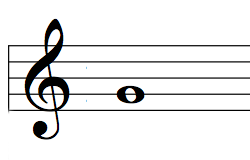
And, once you know what one note it, by going up and down, you know what all the other notes are. Going up one note from G, as we noted above, goes to the next space, which is an "A":
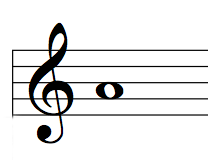
And down from "G" to the space under it would be "F":
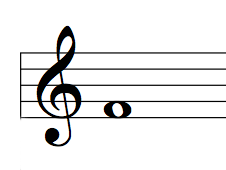
By going up and down this way we find all the lines will be:
E - G - B - D - F
and filling in the spaces between are the notes:
F - A - C - E
Going from line to space to line shows how this works:
E - G - B - D - F
F - A - C - E
How do the flats and sharps fit in? Just put one in front of a note. For instance, G# (G sharp)
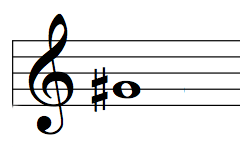
and Ab (A flat)
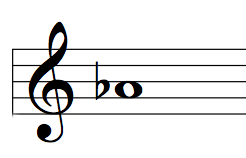
Note letters are useful for talking about music, but for playing, thinking about note names slows you down. When you are learning to play your instrument, when you see a note, think about fingering, not the name of the note. When you see the next note move a step up, think about your fingering stepping up, not the name of the note.
If this seems a little confusing to you, again, just be patient. The more you play on your instrument, the clearer it will all become.
 Beginners Flute Part 1
Beginners Flute Part 1  Beginners Flute Part 2
Beginners Flute Part 2  Beginners Flute Part 3
Beginners Flute Part 3  Beginners Flute Part 4
Beginners Flute Part 4  Beginners Flute Part 5
Beginners Flute Part 5  Beginners Flute Part 6
Beginners Flute Part 6  Beginners Flute Part 7
Beginners Flute Part 7  Beginners Flute Part 8
Beginners Flute Part 8  Beginners Flute Part 9
Beginners Flute Part 9 Beginners Flute Part 10
Beginners Flute Part 10 






